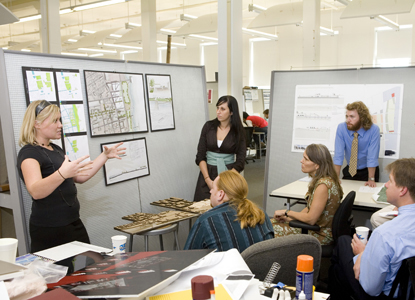 Architecture Students Present their designs at the Savannah College of Art and Design
Architecture Students Present their designs at the Savannah College of Art and Design
On the Ragged Cloth Cafe blog, I wrote about the nature of critiques, mostly summarizing James Elkins’ Why Art Cannot Be Taught; I won’t go into his ideas — you can read a summary on Ragged Cloth if you are interested — but I have been evolving my own thoughts on the subject.
Last Tuesday, in a painting class, the instructor failed to show. We were scheduled for a long critique session, and, being self-sufficient and interested in each other’s art, we continued with the critique ourselves. The critiques in this class had always been group affairs, ones in which the instructor led but did not direct the conversation. So we could easily emulate his processes.
Elkins’ speaks of critiques as fraught with dangers, having multiple ways to can go awry, and he loves the fascinating explications of human nature and thought in action which critiques provide (which is also why they are fraught with dangers).
Some of the danger, as I see it, lies in the fact that while the artist wants information that will help improve her work (and also is hoping to impress the viewers with her artistic abilities and insights), the “panelists” — students or professionals in the field — are almost always struggling to explain what they are seeing. If the panelists (in our case, the other students) are to be successful, they must have insights into the work they are looking at, and then find ways to articulate those insights so that the artist will benefit. It’s a struggle on both sides, since the artist has to be totally alert to the thoughts of the panelists — sorting out, when comments seem confused, whether the speaker are struggling to find her idea, struggling with expressing the idea, or struggling with explaining the idea in terms that will benefit the artist.
And when comments are not confused and the panelist clearly states an opinion or question or makes a comment, the artist has to sort out whether the comment comes out of a concern which the panelist has with his own work or obsession or whether it is truly applicable to the art that is being presented. Other kinds of interface problems can occur — the panelists may get off course and meander into digressions; they may find themselves hostile or overly sympathetic, and so forth.
All this is outside the sometimes awful experience of attack critiques, those legendary events that leave the artist a quivering heap of jelly. I think they arise not out of art or articulation or ideas, but an entirely different culture and one that I haven’t encountered.
Nevertheless, critiques, as I know them, are a substantial and important part of my art education.
In this critique, I limited myself to three works, a “straight” naive/realistic painting of a nearby street scene, a more complex and abstracted view of a warehouse area from above, and a semi-abstract “forest” scene.
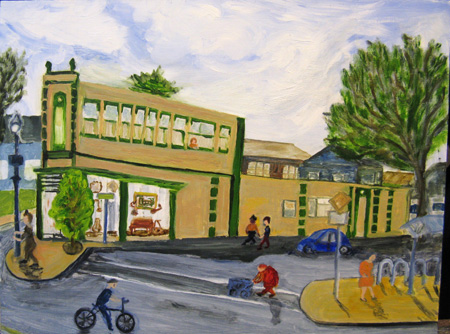
Hawthorne & SE 20th, Mid April, 12 x 16,” oil on board
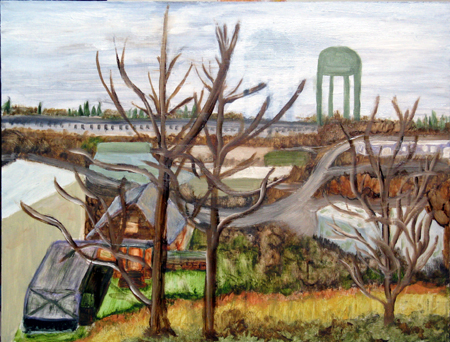
McLoughlin Warehouse District, Mid April. 12 x 16,” oil on board
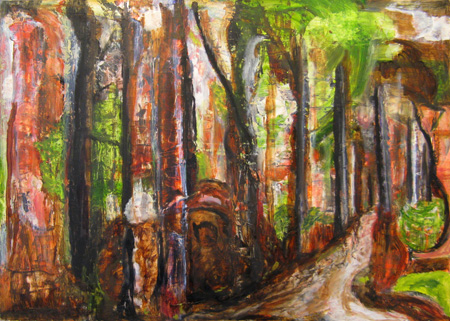
Forest Scene, mid-April, 12 x 16,” oil on board
I was interested in people’s responses to three very different kinds of paintings, all done within a couple weeks of one another. I was particularly interested in this group’s comments, because they are very articulate about what they see. I am somewhat intimidated by their ability to explain what they see, what they like, and how they read a canvas. So I am learning as I listen to them, not just about my art, but about talking about art in understandable ways.
The responses to the three pieces were that they enjoyed the corny street scene, that the colors in the warehouse piece were good (the reproduction here doesn’t do them justice) and that the composition in that one was excellent (they liked the water tower, just as they liked the old lady crossing 2oth Street), and finally that the last was puzzling, interesting, weird, Hansel-and-Gretel-ish,or maybe smelt of Hieronymous Bosch. At any rate, the last, for them, seemed to be coming out of some inner state, whereas the other two were evidences of external scenes. There were other comments but these are the ones that I remember most clearly.
But what the group really wanted to know was where I was going in terms of this last piece. Was this a direction I intended to pursue? What would I be painting next?
I talked for a while, and then realized that the the group consists primarily of abstracting landscape painters — people who take their references from landscape and then work those references into abstractions. Here’s David Trowbridge’s work. David is an accomplished artist, currently exhibiting in downtown Portland, whose work I admire. It is fairly representative of the working process and product of most of the group members.
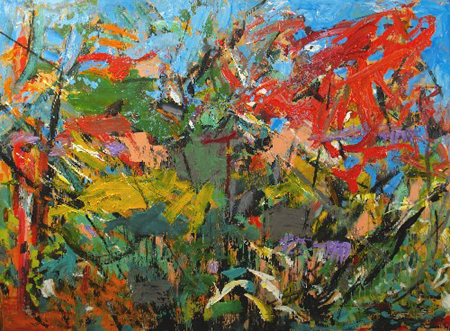
David Trowbridge, Sheffield XI, acrylic and spray paint on plywood, 35.5 x 48″
So when I debriefed myself about the nature of the critique, I had to consider that the abstract attracted the panelist’s attention most because they themselves did art like that. And the questions about where I was going from there were both out of thinking this might be a new path for me, but also a function of knowing that the class was coming close to its conclusion. We were all going to have to decide “where we were going.” I did ask directly and firmly, at least twice at the conclusion of the session, what suggestions they would have for me. They had none.
So my question is, what kinds of critiques have you had that left you with interesting debriefings? Why were the critiques useful? What unanswered questions were there? Do you believe in critiques — if so, what are their limitations?

I feel you have to be lucky to get a good critique of your work. It helps to have an understanding of what you wanted to say in your work and to listen to the critique in terms of whether or not you’ve been successful in delivering your message, otherwise it’s a little like evaluating vegetables. (I love spinach and hate broccoli, but my judgment does not make broccoli bad). It gets down to personal taste.
I like the warehouse painting and going deeper in my understanding of why I like it, it is because it reminds me of someplace I once lived. My telling you this as part of a critique would not help you in understanding your own work, unless you intended for me to feel comfortable and thoughtful about my past. Anything else I would say, would be just making stuff up.
I like the Forest painting because it looks like you are taking some chances, chances I would like to take in my own work. But even here, it all about me. So I question the value of most critiques.
June,
I love how you’ve introduced this topic, in the specific setting of your own critique, with the more general post on critiquing/Elkins at Ragged Cloth (which was fascinating and had a wonderful selection of your paintings, some new to me). And I think it goes to the heart of one key aspect of what Art and Perception is, or could be/should be. Certainly there are different types of posts, and all matter, but what has mattered the most to me are those which have resembled the kind of critiques you and Elkins are talking about. Especially as I’ve never been involved in one elsewhere.
Actually, these virtual critiques have some advantages, such as no time limits and opportunity to think/research before responding. On the other hand, there’s obviously plenty missing, too, perhaps mostly due to the low bandwidth and limited means of expression. By which I mean that seeing and hearing someone speak the words conveys a lot more information than just reading them, and much more can be said in a given time.
I hasten to emphasize that I’m not in the least advocating more focused critiques here. I’m just saying that’s one important aspect of some of our conversations. So to respond to your questions in that (this!) context, these critiques have been very useful to me, both as regards my own work and that of others. I often learn as much critiquing as being critiqued.
Aside from the possibility of treacherous personal interactions, perhaps some dissatisfaction with critiques comes from expecting too much. They can give ideas, questions to think about, but not objectively tell you “how good an artist” you are, or what direction to take. I’m reminded of a favorite quote by Picasso:
Bob,
Your insight about the last painting involving taking chances–something I hadn’t thought of–certainly relates to you and your own painting experience, but I don’t think that means it’s all about you. That grounding in you is what gives it weight, but I think it’s also about the painting and June. There is some reason you made the comment, even if it’s hard to say what it is. I find it illuminating, and probably would even more so if I were the painter.
Bob,
Bob, thanks for your comments. It’s true that our perceptions come from ourselves, so the fact that a piece of art reminds you of where you once lived is totally appropriate.
It is also quite clear to me that I’m painting stuff in Portland that my fellow artists have not observed (even if they live here); this is the obverse of your comment.
Yet you reflect something of what I was feeling when I spotted this place and decided it needed painting: someone lives this warehouse jungle, with these massive concrete buildings all around. And the person who lives there manages to make a space personal and tidy and, dare I say, lovable. So that you’ve lived in such a place, whereas my fellow students are a bit incredulous that such a space exists and want to know more, tells me I’m on the right track. I’m showing new things to some people while validating what exists for others.
I chuckled when I read your comment about “making stuff up.” I feel like that most of the time I’m doing critiques. But then, I realize that “making stuff up” is just looking at the work and thinking about it — not reacting out of an instant’s recognition but actually trying to make words out of what I’m seeing — making stuff up about line and texture and so forth. So I don’t distrust the made-up stuff; I simply see it as the reasonable activity of people who are asked to speak about an odd object and a weird activity and so, out of courtesy and curiousity, they “make stuff up.”
You would like Elkins’ take on critiques, I think.
As for taking chances — it’s an odd moment — the decision to make public work like this. I have consistently shown abstracts to this group, along with a lot more “straight” representational ones, and this was the first time they noticed and approved of. One other they really disliked (it was painful to see them trying to like it). And the rest simply were lost in the crowd. I think it’s because this painting has a trifling of narrative in it, a bit of definable space. More comfort for landscape painters, perhaps.
Steve,
I too benefit from people looking and speaking about my work on this blog. Bob’s comments, for example, were on target and revealed to me a number of things, one of which was that I was accomplishing a bit of what I had hoped.
However, I find the process of making “reasonable” comments about art, even on A&P, to be somewhat exhausting and time consuming, one that I engage in both because others have extended that courtesy to me and because, as you say, the act of making the critiques often helps me understand my own work better. I also think it makes me a more responsible viewer. And of course, viewing good art is always a delight.
In the critique session I discussed above, for example, I saw that one artist had taken a piece that I thought was hopelessly confused and turned it into a successful art work. She did so in part by illuminating space (this was an abstract) with value and overlays — and that informed what I am doing now with my abstract work.
Another artist took a piece that we had seen before and eradicated a whole section of it. I thought the eradication ruined the potential of the piece, but kept my mouth shut and listened to the comments of others. By the end of the session, I realized that I was completely wrong, that her eradication worked, and in the terms of the art, she had succeeded magnificently. I grew to love the piece. So learning about my own art and about my own prejudices and trying hard to keep an open eye were all part of a couple 15 minute adventures in looking and listening.
The let-down people feel about critiques (when they aren’t devastated by them) is explained by Elkins as a seduction and betrayal phenomena. One spends all that time and effort doing the work and getting it ready to show (like getting ready for a date), people come and look and make comments for 15 –45 minutes, and then they go away and the artist is left bereft, alone with her work once again. It’s like being tossed aside by a lover after an exciting evening.
I think maybe a better term than critique is one used by a master artist I worked with a couple of years ago: he talked about a “walk-around.” This was literally a walk around the classroom, examining each artist’s work in something of the manner of a critique but with a lot less pressure. Mobility was an interesting aspect of the walk-around, as was the equality of all the observers including the artist (no one was standing or sitting as a power gesture). This took the feeling of “final exam” out of the process.
The walk-around functioned in the way critiques actually work for me — that is, to get some sense of how my work is seen by eyes other than my own so I can reject those views and emphasize my own in reworking or accept those views and possible enhance the art to reflect them.The addition of movement is also illuminating in some odd way and the informality, if it doesn’t simply dissolve into irrelevance, for me is really helpful.
I teach writing and monitor the “workshop” part of the class very carefully. The main goal of my teaching is to demonstrate the technical components of writing as a craft (i.e., as a constructed thing with components that be worked on individually and objectively to form a cohesive whole) and, thereby, to give the writers a common language of analysis and criticism. Praise is lovely to give and to get, but it often leaves the writer just as befuddled about what to do as does denigration or indifference.
Before we start workshopping, I give the students 4 technical things to look for:
1. something that feels like the beginning
2. something that feels like the conclusion
3. is there a “theme” statement embedded anywhere in the text
4. is there an image or metaphor that can illuminate and unify the text
I also ask them to be alert for the distinction between issues of taste and issues of craft (and that there is a distinction between these things is too often a revelation to my otherwise remarkably sophisticated undergraduates).
Last, I ask the writer whether her (usually the classes are completely or predominantly populated by women) concerns were addressed in the discussion and, if not, to express them so that they can be addressed.
This threefold process is usually fruitful all around — the writer gets useful feedback, the readers develop skill in articulating issues in the text (some of which are quite subtle), and the atmosphere has never yet gone poisonous.
As for myself, when I was writing, I found that the most useful aspect of the workshop/critique was not so much what was said, as what was spoken of. If three or more people commented on a particular aspect of the work, then I looked at it again — why is it calling attention to itself? — and worked to bring it more into line with the whole of the piece. I strove for a particular quality of smoothness in my writing, so anything that leapt out either as particularly beautiful (that’s me showing off) or confusing or awkward (that’s me not thinking things through clearly enough) was reworked to align with goal of smoothness.
I agree that expectations complicate the process, but I disagree that feedback is — or must inevitably be — so subjective as to provide little assistance to the artist. There is some serendipity in how profoundly helpful any discussion will or will not be, and that serendipity depends a great deal on who shows up and how the conversation is moderated — but critiquing has that in common with much of life.
Hi Melanie,
It’s interesting that visual arts and writing have so much in common. The big difference, I suspect, is that in the visual arts, the final critique can mean the final grade and it may be done by professors from outside the artist’s area. So it tends to be a bit more fraught. I suspect that’s where the culture of devastating criticism comes from. Well, that, and a general notion that the duty of authority is to toughen you up.
Your point that there is some “serendipity” in how helpful a critique will be agrees with Elkins’ — he says that “critiques can hold nearly the full range of human responses — and that is only appropriate, because artworks themselves express the widest spectrum of human response….” Of course, he goes on to say that critiques pay “for that richness” and can come “perilously close to total nonsense.” C’est la vie; c’est la critique. Thanks for checking in.
On the other hand, in writing, there’s the devastating assumption that because anyone can speak and most people can read, that writing should be — and is — as effortless as reading or speaking. Ha.
The issue of grading and the perils of academia are entities unto themselves. I award grades four times a year, every year, but that’s just a formality attendant to the way the place is structured. It’s never about the grades, it’s about the learning. People leave my class understanding and practicing writing differently than they did when they came in. That’s all I ask for, and they get points for that.
There’s no substantive difference, between and among the review practices of various disciplines. Except, perhaps, where Steve’s point about expectation comes into play. Some people ‘get’ you, others don’t — that’s as true in the studio as it is in the grocery store. Really, it is. The problem comes in wanting to be understood and celebrated without having to go through the trouble of making yourself clear, or, if you have made yourself clear, without having to go to the effort of finding the tribe who will celebrate you. The yearning for so-called unconditional love is a natural desire, but not always practicable.
I agree there’s much commonality in review practices across disciplines, and I’m tempted to illustrate it by applying your four-point method. What I come up with, in the case of the third painting, is a beginning among the dark, almost overwhelming trees, a conclusion of following the inviting road, and a theme/metaphor of the journey. This is simplistic, but gives a starting point–and at this point I realize I haven’t looked at a painting quite this way before, as a journey for the viewer that might have a detectable starting point and direction. It seems to work for the second painting as well–foreground trees to background water tower–but not in the first, where various people are moving around, but there’s no general motion for me as viewer. Which is not good or bad, but helps me understand the difference better. I want to say I personally prefer the two with implied viewer motion, but then I look at my photographs (previous post) and realize they are either pretty static (3 and 4), or the dominating bright mist essentially halts the downward movement. Hmmm… I’m beginning to blather, but it feels like I learned something in the process.
On commonality across disciplines, there does seem to be a difference between art and science in how easy it is to articulate and communicate ideas. Considering the review as a means of providing community help for the reviewee, it seems much more straightforward in science to give useful advice on dealing with problems with experiments, or problems in interpretation of results, or even choice of goals.
The Forest Scene is about the June that I know and love. Visiting Germany, the adjective that comes to my mind is glaesern. What is the translation? Crystalline, glassy?
Crystalline panorama to the left, inviting me to peer through without encouraging my usual behavior of lumbering cross country. Instead, I am allowing myself to be gliding ahead, following the path. There is a feeling of magic, some Alice in Wonderland.
Wonderful juxtaposition of rigidly crystalline magic with the flow of a magical path.
Melanie,
That makes so much sense to me!
Melanie,
I think while there are many similarities among critiques, especially in the arts (Elkins speaks to philosophy and science and makes comparisons), I suspect there are some substantive differences, and some less substantive which rely primarily on language.
For example, what you call “beginning” and “conclusion” (and what Steve looked at) would in visual arts perhaps be called “Space” and Movement.” Another phrase often used is “a way in…” (into the painting, that is). The “way in” is often contrasted as equal to but very different from “overall” pattern or imaging. Movement and space don’t necessarily imply beginning; it’s perhaps the frame of the painting that implies a beginning and end, so “a way in” might become a kind of substitute for “beginning.”
Unity and theme are equally important words across the two arts, I think, and used in the much the same way. But it would be fun to do comparisons with other aspects of writing and visual critiques.
On my wall I have a note of foci that I currently want to keep in mind as I paint: “space, shape, shadow, and pattern.” I don’t need beginning and end and narrative, because those seem to come to me without much trouble (the frame of the canvas helps). And movement also seems easier for me to achieve without much thought. But the aspects of painting that don’t come easily are ones that memory triggers, like my little post-it note, really help.
Which makes me wonder — what would Jay put on his wall as a reminder of what he wants to think about? And Steve, what do you miss when you photograph that you later wish you had included? Birgit? Bob? D? Does anyone else make mental notes to pay closer attention to ——-?
Birgit,
I should have known you would like the path. I am hesitant about paths in my paintings — they are a cheap way to provide movement and are sometimes overused by less-than-sterling painters. But they are also extremely useful in anchoring chaos (which, when I think about it, is their actual usefulness also!)
Melanie, Birgit has picked out the quote from your comment that speaks to me also.
June,
I have occasionally written down little reminder lists of things to think about, but I almost always forget to look at them when actually out photographing. I’ll have to see if I can locate one (doubtful). I remember having “rhythm” on such a list, but I can’t recall anything else at the moment.
Dancing and singing come to mind. Steve’s ‘rhythm’ is a good mantra.
My primary intentions with the workshop questions are to let the workshopping process function while the students are developing an understanding of the dozen or so components of narrative that are in play at given moment in a writing, and to pre-empt the devolution into what truly is a dead-end:
“I liked it.”
“What did you like about it?”
“I dunno. But I really liked it.”
When I say that there’s no substantive difference between and among the review practices of various disciplines, I mean that, inasmuch as all the disciplines include training in how to think about problems, they have more in common than it might at first seem. And since all the disciplines are peopled with people, they have the same range of anxieties that go with the territory of being a person.
Certainly, other forms, regardless of their Balkanizing into categories such as “art” and “science” will have their idiosyncratic languages and will have other foundational keys to approaching the work. At a recent SAQA (Studio Art Quilt Associates) meeting, for example, the moderator introduced a process for critiquing that used a similar foundational approach — What is the silhouette of the piece? What are the main colors? How big is it? Abstract? Realistic? Is there a subject? If so, what is it? — before moving into more subjective areas about how these components reveal the artist’s intention and inform or direct the viewer’s reception of the work.
In “A Brief Tour of Human Consciousness,” V. S. Ramachandran has a fascinating chapter on the perception of art, including what he suggests as the 10 universal laws of art. Dr Ramachandran is a neurobiologist and psychologist and, as the Director of the Center for Brain and Cognition at UCal San Diego, has been doing some extraordinary work on consciousness. He’s very good at explicating the neurochemistry of thinking and feeling. The chapter concerning art &c (“The Artful Brain”) is available at: http://www.educause.edu/ir/library/pdf/ffpiu049.pdf
Melanie,
Inspirational comments. Teaching a course on neurobiology (embryonic development/neurological diseases), my major concern, so far, has been to help undergraduates to cope with challenges presented by the original literature. Reading your comments, I am thinking about stimulating more creative discussions of the research (depending, how soon I will reinvent myself as an artist).
In the movie “Ratatouille” (I know, I am not very deep) the critic succumbs to his memory of his youth and because of this declares the chef the greatest ever. The point that I am looking to make is that more often then not we can’t get ourselves out of the way and our personal likes and dislikes are a huge part of any critique we do.
I understand that in a academic setting there is a need to apply a system for judging progress, skill, the ability to follow rules etc. But if art is to be synonymous with creativity, then how you do something becomes less important then what you’ve done.
Yes I sometimes make a note on what not to forget when I start a painting, but once the (metaphorically) music starts to play the rhythm takes over and I am dancing, no longer paying attention to my notes. My feet or my brushes are taking me where I need to go.
Recently I was on a panel to select winners at a high school art exhibit. One of my fellow judges was an architect and we disagreed on two abstract paintings. The painting that I liked I saw as being entertaining (he laughed at me) and the painting that he liked he saw as being well constructed. We settled on another painting that was reasonably both entertaining and well constructed.
Bob,
Good to know that one can expect from a panel to arrive only at a common denominator rather than to appreciate the unique. Thus, not being a winner would be a more desirable position to be in. (my contrary streak)
Birgit
Yes this is unfortunate, feedback sometimes gets compromised.
The compromise seems reasonable when it’s necessary to select a single “winner.” For purposes of feedback, providing multiple opinions is not only more likely useful for the artist, but also underlines the subjectivity of the process, which may help reduce the impacts of any disappointments or disagreements.
Birgit
Re #17 above
Glad to have helped. I have trouble getting my oh-so-contemporary young ones to wrap their minds around Samuel Johnson — who is quite sly and rather elegantly sarcastic once you settle into the 18th-century sentence structure.